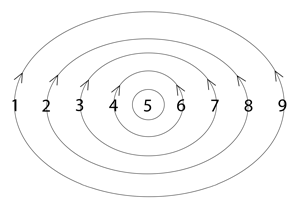creating
6-8-5
Conventional Understanding
In conventional thinking, “creating” means making something new. We see it as something we do – a person produces something that didn’t exist before. Our education celebrates “creating” as requiring effort and skill. This view positions humans as originators rather than participants in a natural process.
Resonant Understanding
Word Cosmology shows “creating” has a 6-8-5 pattern, placing it at Position 5 in the Experiential Triad. Like a doorway where potential becomes visible, “creating” is the active process where generative energy becomes perceptible. This explains why artists often say creating feels more like discovery than invention – they’re experiencing the threshold where potential becomes recognizable reality.
Expressions Spectrum Analysis
In balanced expression, this pattern appears as “align with being,” “be present,” and “fluid identity.” “Fully being” and “aware energy” show how balanced creating involves receptive awareness rather than forced effort. “I share my message” shows natural expression without struggle.
When over-modulated, expressions include “demand,” “label,” and “stuck in identity,” showing how control distorts the natural process. “I have to get ahead” reveals the pressure that emerges when creating becomes about achievement rather than presence.
Under-modulated expressions like “depressed,” “fake,” and “slave” show what happens with insufficient engagement. “I am afraid of breathing” reveals the disconnection that occurs when we withdraw from direct experience.
Beyond these patterns, words like “mind idea,” “patterns,” and “language results in form” share this same resonance, pointing to fundamental organizing principles.
Russell’s Cosmogony Connection
Walter Russell’s work illuminates how “creating” functions at Position 5. He writes:
“Mind thinking is electric. Divided electric thought pulsations manifest creative desire in wave cycles of motion, which forever vibrate between the two electric thought conditions of CONCENTRATION and DECENTRATION.”
This vibration between concentration and decentration corresponds with the active process at Position 5, where potential becomes perceptible through two-way motion. “Creating” isn’t producing something from nothing, but participating in the rhythmic movement where ideas become experientially real.
In the creation family, “creating” (6-8-5) at Position 5 follows “creation” (3-1-4) at Position 4 and precedes “creativity” (4-2-6) at Position 6, showing the sequential unfolding of the creative process.
Practical Implications
This understanding transforms how we approach creativity. Rather than forcing new things into existence through effort, we might recognize creating as being present at the threshold where potential naturally becomes perceptible.
This perspective helps with creative blocks, which often happen when we try to “create” (Position 7) without connection to the generative field. Practices that enhance presence – meditation, flow states, relaxed attention – often enhance creativity more effectively than forced production.
When we recognize creating’s position in the creative sequence, we engage differently with creative processes – not forcing outcomes but becoming more present at the threshold where potential naturally becomes perceptible. This is why expressions like “fluid identity” and “appreciate consciousness” appear in balanced expressions – they show direct experience flowing without distortion from either excessive control or insufficient engagement.
Walter Russell’s quotes are from his book, “A New Concept of the Universe”.


